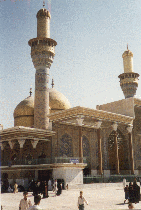
On Wednesday, Aug. 31, upwards of a thousand Muslim pilgrims died in a panic on a bridge in Baghdad. In a matter of minutes there were at least half as many fatalities as American forces have suffered so far in the entire Iraq War. This time there was no suicide bomber, but fear of an attack proved just as deadly.
The pilgrimage that left so many women and children dead was itself an act of mourning for the execution 1200 years ago of the seventh Imam in Shi’a tradition, Imam Musa ibn Ja’far al-Sadiq. Partisans believe the imam was poisoned by the fabled “Arabian Nights†Abbasid caliph Harun al-Rashid while he was in the custody of the chief of police in Baghdad. Musa ibn Ja’far lingered on for three days until achieving martyrdom in the eyes of his countless followers over the centuries.
The jealous caliph, so it is said, wanted everyone to see that his rival was gone. The body was hung up on a bridge over the Tigris. “This is Musa ibn Ja’far. He is dead. Come on and look at him,†cried the herald. Those were evil days, when a direct descendant of the Prophet was killed yet again. Now a Baghdad bridge is once again a scene of death, this time a thousandfold. Once again the lives of more Iraqi families are broken.
Only about 250,000 pilgrims turned out for the ill-fated ceremony on the Imamayn Bridge on Wednesday in honor of the revered martyr, one of many of the Shi’a. This was an off year for attendance due to security threats. But why do so many people, mainly women and children, come to remember a man so long dead? You might as well ask why so many moviegoers went to see Mel Gibson’s “The Passion of the Christâ€. Martyrs never really die. Their deaths need to be relived so that our own sufferings pale by comparison. On Wednesday those who mourned a martyr became new martyrs.
No bombs went off among these mourners. No planes strafed the streets. Ordinary, innocent Iraqis caught in a web of terror were consumed by panic and stampeded to their death, many falling off the bridge into the Tigris. Yet on the same day there were more suicide explosions in Iraq. American planes searching for al-Qaeda targets killed and maimed civilians. More American soldiers died. It was a day like any other day of the past year, not unlike that day of political terror 1,200 years ago when Imam Musa ibn Ja’far was assassinated. History is not only repeating itself, it is doing so with a vengeance.
The real tragedy on the bridge is that it can only be described as an act of God in a living hell where God is on everyone’s lips. Sunni and Shi’a are fighting the battles that made so many martyrs in the past. The goal is power, but the rhetoric is religious.
The President of the United States believes that his higher Father sanctioned the American invasion. The goal is democracy, but the reality is near-anarchy. There is no end in sight for mourning the dead in this conflict. Iraq today looks like a country that even God has forsaken. It matters not which name you call God. And that may be the worst part of this ongoing tragedy.
Daniel Martin Varisco
[Published on Pacific News, September 3, 2005]